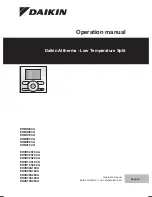
EKC 361
Manual RS8AE802 © Danfoss 12-2009
13
Method for fixing Kp, Tn and Td
Described below is a method (Ziegler-Nichols) for fixing Kp, Tn
and Td.
1. The system is made to regulate the temperature at the required
reference with a typical load. It is important that the valve regu
-
lates, and that it is not fully open.
2. Parameter u05 is read. The actuator’s min. and max. setting is
adjusted, so that the average of the min. and max. values is
equal to the read u05.
3. The controller is set, so that it will regulate as a P-controller. (Td is
set to 0, Tn in pos. OFF (600), and Q-Ctrl.mode is set at 0).
4. The stability of the system is examined by stopping the system
for, say, one minute (using the start/stop setting or the switch).
Now check how the building-up of the temperature proceeds.
If the building-up peters out, raise Kp a little and repeat the
start/stop operation. Continue with this until you obtain a build
-
ing-up which does
not
peter out.
5. Kp is in this case the critical amplification (Kp
critical
) and the build-
ing-up time for the continued oscillation is the critical building-
up time (T
critical
).
6. Based on these values, the regulating parameters can now be
calculated and subsequently set:
• If PID regulation is required:
Kp < 0.6x Kp
critical
Tn > 0.5x T
critical
Td < 0.12x T
critical
• If PI regulation is required:
Kp < 0.45x Kp
critical
Tn > 0.85x T
critical
7. Reset the values for the controller’s min. and max. tem peratures
and Q-Ctrl.mode.
Adjustment of the actuator’s min. and max. temperatures
At the first setting these values were set to 10 K outside of the
expected temperature in order to eliminate the tolerances in the
actuator. By adjusting the two values to the values where the
valve is exactly in mesh, the valve will all the time remain active in
its regulation.
If the actuator is replaced at a later date, this procedure must be
repeated for the new actuator.
Min.
By adjusting the actuator’s min. temperature you obtain a limit
for how low a pressure can occur in the evaporator (the point is
where the valve starts a limitation of the refrigerant flow).
The system must be put in an operating situation where max.
capacity is called for (large refrigeration need).
The min. temperature must now be changed upwards step by
step, at the same time as the evaporating pressure is read on the
system’s manometer.
When a change of the evaporating pressure is registered, this is
the point where the valve is exactly in mesh. (If frost protec tion is
required for the system, the value can be raised to the belonging
value).
Max.
By adjusting the actuator’s max. temperatur you obtain a limit for
how high a pressure can occur in the evaporator (the refrigerant
flow is blocked completely).
The system is put in an operating situation where there is no call
for refrigeration capacity (no refrigerant flow).
The max. temperature is now changed downwards step by step, at
the same time as the evaporating pressure is read on the system’s
manometer.
When a change of the evaporating pressure is registered, this
is the point where the valve opens. Adjust the setting a little
upwards, so that the valve will again close completely for the
refrigerant flow. (If the actual application has a requirement re
-
garding max. evaporating pressure, a lower setting may of course
be selected, so that the pressure is limited).
Fine adjustments
When the system has been operating for a while, it may be
required for some systems to optimise some of the adjustments.
Below we have a look at settings having an influence on the speed
and accuracy of the regulation.


































